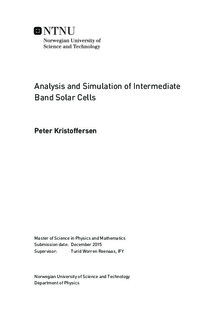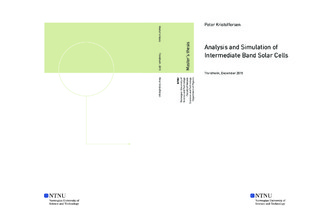| dc.description.abstract | Intermediate band solar cells (IBSC) is a technology that promises higher efficiency solar cells with comparatively simpler structure than the currently best performing solar cells on the market. In this work, different steps towards the assessment of IBSC materials for use in solar cells have been made. The work has been divided into three parts: Development of a simulation program for intermediate band materials; measurement of stray light in the photoluminescence apparatus; and luminescence measurement on IBSC samples.
The first part of the thesis is a simulation program for IBSC which calculates the carrier concentrations, generation and recombination currents in and between bands. It builds on the doctoral work of Maryam G. Mayani, but fixes a couple of errors and adds calculation of Auger recombination, which in certain materials dominate over Shockley-Read-Hall recombination at higher carrier concentrations. This simulation of Auger recombination has never been done with intermediate band solar cells. The contribution of the Auger recombination is important at higher illumination concentrations where the carrier concentrations are often higher.
From earlier work with photoluminescence done at the Department of Physics at NTNU, problems were noticed with the new equipment. Because of this, luminescence has been rarely used for analysis by the members of the Solar Cell Physics group at the department. The problem stems from stray light in the sample chamber of the photoluminescence device. The second part of my work was to analyze and suggest a way of mitigating the detrimental effects of this light on the results. The source of the stray light was determined to be due scattering on the monochromator walls.
As it became apparent that the current setup was unsuited to my planned measurements, work was delayed until we could add a high-frequency laser to the machine, a process that was completed in the August 2015.
The final part of the thesis is comparing luminescence spectra of Cr:ZnS IBSC obtained with photoluminescence and electroluminescence, to find out if one is better than the other at analyzing intermediate band materials. Unfortunately, repeated delays gave me little time to establish an experimental procedure and make measurements and do analysis. Measurements were done using three different setups, but the results were lacking and inconclusive and are presented in the appendix. | |

